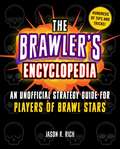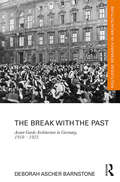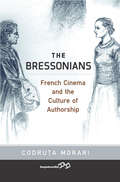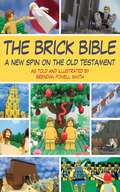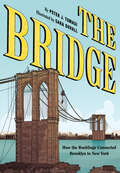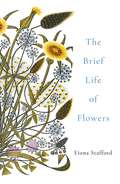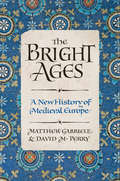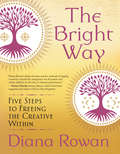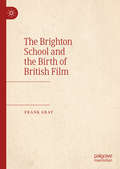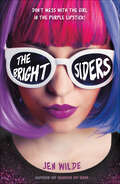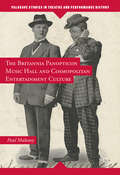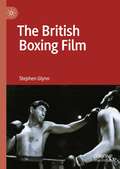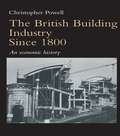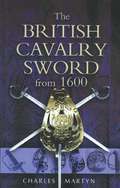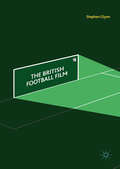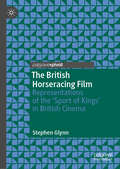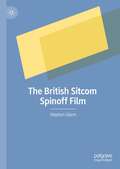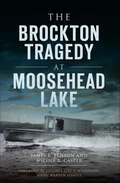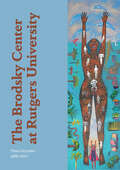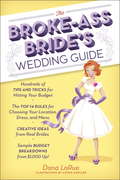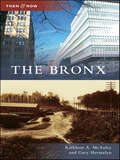- Table View
- List View
The Brawler's Encyclopedia: An Unofficial Strategy Guide for Players of Brawl Stars
by Jason RichThe Must-Own Insider's Guide to the Gaming Sensation! Brawl Stars is one of the latest real-time multiplayer gaming phenomena to captivate players all over the world. Players team up in threes to navigate mazes, shoot at enemies, and collect colorful gem stones. In order to triumph, players must react quickly, aim precisely, and develop strategy to perform well in each three-minute match. To keep the game interesting, Brawl Stars offers several unique game play modes, each focusing on a different primary challenge. With the valuable tips in this illustrated, information-packed guide, gamers will be better equipped to: Develop strategies for success at each different level. Master the various playing arenas (mazes) and snag more wins. Take advantage of the unique features of each gameplay mode. The Brawler's Encyclopedia will introduce young readers to this exciting and challenging game. This full-color how-to guide includes hundreds of full-color screenshots showcasing some of the more collectible skins that can be unlocked or purchase and explaining all aspects of the game in a way that appeals to newbs and experienced gamers.
The Brazilian Photographs of Genevieve Naylor, 1940-1942
by Robert M. LevineIn the early 1940s as the conflict between the Axis and the Allies spread worldwide, the U.S. State Department turned its attention to Axis influence in Latin America. As head of the Office of Inter-American Affairs, Nelson Rockefeller was charged with cultivating the region's support for the Allies while portraying Brazil and its neighbors as dependable wartime partners. Genevieve Naylor, a photojournalist previously employed by the Associated Press and the WPA, was sent to Brazil in 1940 by Rockefeller's agency to provide photographs that would support its need for propaganda. Often balking at her mundane assignments, an independent-minded Naylor produced something far different and far more rich--a stunning collection of over a thousand photographs that document a rarely seen period in Brazilian history. Accompanied by analysis from Robert M. Levine, this selection of Naylor's photographs offers a unique view of everyday life during one of modern Brazil's least-examined decades.Working under the constraints of the Vargas dictatorship, the instructions of her employers, and a chronic shortage of film and photographic equipment, Naylor took advantage of the freedom granted her as an employee of the U.S. government. Traveling beyond the fashionable neighborhoods of Rio de Janeiro, she conveys in her work the excitement of an outside observer for whom all is fresh and new--along with a sensibility schooled in depression-era documentary photography of Dorothea Lange and Walker Evans, as well as the work of Cartier-Bresson and filmmaker Serge Eisenstein. Her subjects include the very rich and the very poor, black Carnival dancers, fishermen, rural peasants from the interior, workers crammed into trolleys--ordinary Brazilians in their own setting--rather than simply Brazilian symbols of progress as required by the dictatorship or a population viewed as exotic Latins for the consumption of North American travelers.With Levine's text providing details of Naylor's life, perspectives on her photographs as social documents, and background on Brazil's wartime relationship with the United States, this volume, illustrated with more than one hundred of Naylor's Brazilian photographs will interest scholars of Brazilian culture and history, photojournalists and students of photography, and all readers seeking a broader perspective on Latin American culture during World War II.Genevieve Naylor began her career as a photojournalist with Time, Fortune, and the Associated Press before being sent to Brazil. In 1943, upon her return, she became only the second woman to be the subject of a one-woman show at New York's Museum of Modern Art. She served as Eleanor Roosevelt's personal photographer and, in the 1950s and 1960s became well known for her work in Harper's Bazaar, primarily as a fashion photographer and portraitist. She died in 1989.
The Break with the Past: Avant-Garde Architecture in Germany, 1910 – 1925 (Routledge Research in Architecture)
by Deborah Ascher BarnstoneBetween 1918 and 1933 the German interwar avant-garde was a primary force driving European cultural innovation and modernism. These innovations continue to influence artistic practice, theory, and arts education today, thus making a comprehensive study of the relationship between individual war experience and the immediate response of avant-garde architects after the war all the more important. The Break with the Past pursues several important, interrelated questions. What were the disparate war experiences of German architects, and did they have different effects on Weimar cultural production? Did political orientation play a part in support for the war? In aesthetic choices? What changes occurred in avant-garde architectural practice after 1918? How do they compare with pre-war positions and practices, and expectations for post-war outcomes? In order to address these questions, the book uses individual case studies of four leading architects: Bruno Taut, Walter Gropius, Erich Mendelsohn, and Hans Scharoun. This is a valuable resource for academics and students in the areas of Art and Architecture History, German history and Cultural Studies, European Culture and Modernism.
The Bressonians: French Cinema and the Culture of Authorship
by Codruţa MorariHow should we understand film authorship in an era when the idea of the solitary and sovereign auteur has come under attack, with critics proclaiming the death of the author and the end of cinema? The Bressonians provides an answer in the form of a strikingly original study of Bresson and his influence on the work of filmmakers Jean Eustache and Maurice Pialat. Extending the discourse of authorship beyond the idea of a singular visionary, it explores how the imperatives of excellence function within cinema’s pluralistic community. Bresson’s example offered both an artistic legacy and a creative burden within which filmmakers reckoned in different, often arduous, and altogether compelling ways.
The Brick Bible: A New Spin on the Old Testament
by Brendan Powell SmithBrendan Powell Smith has spent the last decade creating nearly 5,000 scenes from the bible--with Legos. His wonderfully original sets are featured on his website, Bricktestament.com, but for the first time 1,500 photographs of these creative designs--depicting the Old Testament from Earth's creation to the Books of Kings--are brought together in book format. The Holy Bible is complex; sometimes dark, and other times joyous, and Smith's masterful work is a far cry from what a small child might build. The beauty of The Brick Bible is that everyone, from the devout to nonbelievers, will find something breathtaking, fascinating, or entertaining within this collection. Smith's subtle touch brings out the nuances of each scene and makes you reconsider the way you look at Legos--it's something that needs to be seen to be believed.
The Bridge Battle (The Lemonade War Series #6)
by Jacqueline DaviesIn this gripping, funny addition to the bestselling Lemonade War series, both Jessie and her brother Evan find themselves unexpectedly cast as outsiders. How they find their way forward makes for a timeless story about the power of courage and kindness.Evan and Jessie Treski have waged a lemonade war, sought justice in a class trial, unmasked a bell thief, and created a professional magic show. Yet for all their skills and talents, both find themselves being singled out this summer for reasons beyond their control.Natural-born leader Evan, who is always good at making new friends, discovers he is at the mercy of a bully on the summer school playground, and is pressured to act in a way he never has before.Science-loving Jessie just wants to construct the best bridge she can for the competition next month, yet she is stuck in the wrong summer camp, surrounded by kids who believe fairies are more real than physics and a group of girls who tortured her back in second grade. Suddenly, she, too finds herself acting in ways that puzzle her.Bestselling author Jacqueline Davies once again shows how well she understands her readers in this timely story of how being true to ourselves can help us remember how to treat others.
The Bridge: How the Roeblings Connected Brooklyn to New York
by Peter J. TomasiA graphic novel depicting the history of the construction of the Brooklyn Bridge and the family that made it happen.In this extraordinary graphic novel, author Peter J. Tomasi and illustrator Sara DuVall bring to life the construction of one of the most iconic landmarks in the world and shine a light on the incredible triumphs and tragedies that went into building the Brooklyn Bridge. After the accidental death of John Augustus Roebling in 1869, it was up to Roebling’s son Washington to complete the massive project. Unfortunately, there was more pain to follow, as Washington developed caisson disease, leaving him bedridden. Washington’s wife, Emily, deftly assumed a key role in the bridge’s construction by becoming her husband’s eyes and ears at the work site. As Washington’s wisest council, Emily skillfully navigated work crews who now had to answer to a woman, contractors, a hostile press, and a greedy city politician—all looking to take credit for the magnificent bridge slowly making its way across the East River. Through it all, the Roeblings persisted, rising above every obstacle to build the great bridge that connects Brooklyn and New York. “Told by prolific superhero scribe Tomasi . . . with charmingly understated art by the Eisner-nominated Duvall . . . this historical graphic narrative presents dramatic events in a matter-of-fact, realistic way. . . . Rather than being a story of a singular genius overcoming adversity, the book is a paean to collaboration. Iconic structures often have fascinating stories behind them, but rarely do the tellings emphasize the human as this one does,” —Publishers Weekly“[Tomasi] does a magnificent job of depicting the politics, the danger, and the tenacity of the Roebling family and the hundreds of workers who built the bridge,” —Good Comics for Kids
The Brief Life of Flowers
by Fiona StaffordThe beauty of flowers is well known, inspiring creative minds from Botticelli to Beatrix Potter. But they've also played a key part in forming the past, and may shape our future.Roses and thistles have served as symbols of monarchs, dynasties and nations. We wear poppies to remember the First World War, but it was the elderflower that treated its wounded soldiers. A rose might mend a broken heart, and sunflowers may just save our planet. At once enchanting and intriguing, The Brief Life of Flowers reveals how even the most ordinary of flowers have extraordinary stories to tell.
The Bright Ages: A New History of Medieval Europe
by David M. Perry Matthew Gabriele"Traveling easily through a thousand years of history, The Bright Ages reminds us society never collapsed when the Roman Empire fell, nor did the modern world did wake civilization from a thousand year hibernation. Thoroughly enjoyable, thoughtful and accessible; a fresh look on an age full of light, color, and illumination." —Mike Duncan, author of Hero of Two Worlds: The Marquis de Lafayette in the Age of Revolution A lively and magisterial popular history that refutes common misperceptions of the European Middle Ages, showing the beauty and communion that flourished alongside the dark brutality—a brilliant reflection of humanity itself.The word “medieval” conjures images of the “Dark Ages”—centuries of ignorance, superstition, stasis, savagery, and poor hygiene. But the myth of darkness obscures the truth; this was a remarkable period in human history. The Bright Ages recasts the European Middle Ages for what it was, capturing this 1,000-year era in all its complexity and fundamental humanity, bringing to light both its beauty and its horrors. The Bright Ages takes us through ten centuries and crisscrosses Europe and the Mediterranean, Asia and Africa, revisiting familiar people and events with new light cast upon them. We look with fresh eyes on the Fall of Rome, Charlemagne, the Vikings, the Crusades, and the Black Death, but also to the multi-religious experience of Iberia, the rise of Byzantium, and the genius of Hildegard and the power of queens. We begin under a blanket of golden stars constructed by an empress with Germanic, Roman, Spanish, Byzantine, and Christian bloodlines and end nearly 1,000 years later with the poet Dante—inspired by that same twinkling celestial canopy—writing an epic saga of heaven and hell that endures as a masterpiece of literature today. The Bright Ages reminds us just how permeable our manmade borders have always been and of what possible worlds the past has always made available to us. The Middle Ages may have been a world “lit only by fire” but it was one whose torches illuminated the magnificent rose windows of cathedrals, even as they stoked the pyres of accused heretics. The Bright Ages contains an 8-page color insert.
The Bright Way: Five Steps to Freeing the Creative Within
by Diana RowanThe Bright Way is an interactive handbook for mastering Diana Rowan’s proven system for freeing your innate creativity. The Bright Way System has helped thousands of creatives regain their inspiration and motivation, and move past fears so that they can courageously share their visions with the world. It is based on these three principles: 1. Everyone is creative. Creativity happens whenever you directly engage with your chosen activity. (It isn’t just for artists!) 2. You must be creative to be fulfilled in life. If you’re unengaged with life, you will feel dissatisfied, like something is missing. Engage directly with life by reigniting your creativity so that you come back home to your true self. 3. You can tap into your creativity anytime, anyplace, at any age. It’s never too late, and no matter the circumstances, you can be creative. Written for all creatives from young adults to seniors, The Bright Way’s empowering and reliable system works for a lifetime to help you:move through creative blocks so that your creativity consistently flowstransform performance fear into joyful sharing of your workfinally let go of self-doubt and embrace unshakable self-confidenceInspired by Diana’s own journey from severe creative performance anxiety to a fulfilling career as a full-time artist, this handbook is packed with actionable tips and dozens of examples so that you can make this simple yet powerful system truly your own. Start your Bright Way journey today to access your unique creative voice and shine your light in our new world!
The Brighton School and the Birth of British Film
by Frank GrayThis study is devoted to the work of two early British filmmakers, George Albert Smith and James Williamson, and the films that they made around 1900. Internationally, they are known collectively as the ‘Brighton School’ and are positioned as being at the forefront of Britain’s contribution to the birth of film. The book focuses on the years 1896 to 1903, as it was during this short period that film emerged as a new technology, a new enterprise and a new form of entertainment. Beginning with a historiography of the Brighton School, the study goes on to examine the arrival of the first 35mm films in Britain, the first film exhibitions in Brighton and the first projection of film in Brighton. Both Smith and Williamson’s work features a progression from the production of single shot unedited films to multi-shot edited films. Their subject matter was inspired by a knowledge of contemporary pantomime, humour, literature, theatre, mesmerism, the magic lantern and current affairs and their practices were underpinned by active involvement in the new film trade. Through the exploration of how these filmmakers cultivated a new way of understanding film and its commercial potential, this book establishes them as key figures in the development of British film culture.
The Brightsiders
by Jen WildeA teen rockstar has to navigate family, love, coming out, and life in the spotlight after being labeled the latest celebrity trainwreck in Jen Wilde's quirky and utterly relatable novel. As a rock star drummer in the hit band The Brightsiders, Emmy King’s life should be perfect. But there’s nothing the paparazzi love more than watching a celebrity crash and burn. When a night of partying lands Emmy in hospital, she’s branded the latest tabloid train wreck. Luckily, Emmy has her friends and bandmates, including the super-swoonworthy Alfie, to help her pick up the pieces of her life. She knows hooking up with a band member is exactly the kind of trouble she should be avoiding, and yet Emmy and Alfie Just. Keep. Kissing.Will the inevitable fallout turn her into a clickbait scandal (again)? Or will she find the strength to stand on her own?Jen Wilde, author of Queens of Geek, which Seventeen called, “the geeky, queer book of our dreams” is back with a brand new cast of highly diverse and relatable characters for her fans to fall in love with.Praise for Queens of Geek:"The book deals head on with issues of mental health, body shaming, sexuality, and internet celebrity, handling them with a delicate and skillful touch." —Teen Vogue"This fun book about fierce friendships gives voice to a group of diverse female characters who are so defined by so much more than just their mental health and sexuality." —Bustle"This celebration of geek culture and fandom promotes diversity and being true to oneself." —School Library Journal
The Britannia Panopticon Music Hall and Cosmopolitan Entertainment Culture
by Paul MaloneyFocusing on Glasgow's earliest surviving music hall, the Britannia, later the Panopticon, this book explores the role of one of the city's most iconic cultural venues within the cosmopolitan entertainment market that emerged in British cities in the nineteenth century. Shedding light on the increasing diversity of commercial entertainment provided by such venues - offering everything from music hall, early cinema and amateur nights to waxworks, menageries and freak shows - this study also encompasses the model of community-based, working-class music hall which characterised the Panopticon's later years, challenging narratives of the primacy of city centre variety. Providing a comprehensive analysis of this dynamic popular theatre of the industrial age, Maloney examines the role of the hall's managers, marketing and promotional strategies, audiences, and performing genres from the hall's opening in 1859 until final closure in 1938. The book also explores stage representations of Irish and Jewish immigrant communities present in surrounding city centre areas, demonstrating the Britannia's diasporic links to other British cities and centres in North America, thus providing a multifaceted and pioneering account of this still extant Victorian music hall.
The British Aesthetic Tradition: From Shaftesbury to Wittgenstein
by Timothy M. CostelloeThe British Aesthetic Tradition: From Shaftesbury to Wittgenstein is the first single volume to offer readers a comprehensive and systematic history of aesthetics in Britain and the United States from its inception in the early eighteenth century to major developments in the late twentieth century. The book consists of an introduction and eight chapters, and is divided into three parts. The first part, The Age of Taste, covers the eighteenth-century approaches of internal sense theorists, imagination theorists, and associationists. The second, The Age of Romanticism, takes readers from debates over the picturesque through British Romanticism to late Victorian criticism. The third, The Age of Analysis, covers early twentieth-century theories of Formalism and Expressionism to conclude with Wittgenstein and a number of views inspired by his thought.
The British Boxing Film
by Stephen GlynnThis book constitutes the first full volume dedicated to an academic analysis of the sport of boxing as depicted in British film. Through close textual analysis, production and reception histories and readings that establish social, cultural and political contexts, the book explores the ways in which prizefighters, amateur boxers, managers and supporters (from Regency gentry to East End gangsters) are represented on the British screen. Exploring a complex and controversial sport, it addresses not only the pain-versus-reward dilemma that boxing necessarily engenders, but also the frequently censorious attitude of those in authority, with boxing’s social development facilitating a wider study around issues of class, gender and race, latterly contesting the whole notion of ‘Britishness’. Varying in scope from Northern circuit comedies to London-based ‘ladsploitation’ films, from auteur entries by Alfred Hitchcock to programme fillers by E.J. Fancey, the boxing film also serves as a prism through which one can trace major historical shifts in the British film industry.
The British Building Industry since 1800: An economic history
by Christopher PowellThis scholarly and well-researched study of the building industry documents the interplay of new materials and technologies, costs and the changing social and economic forces that affected the decision-making about our built environment over the last two centuries. The author provides a succinct and readable survey of the growth and development of British building which will be of interest to all building specialists and those training for a career in the construction industry.
The British Cavalry Sword From 1600
by Charles MartynA simplistic and informative guide to British Cavalry Swords that does not claim to be an academic treatise. The essential features are demonstrated by photographs and descriptions of swords from the author's own collection, supported by sketches of sword hilts that have not been generally publicised.
The British Cinema Boom, 1909–1914: A Commercial History
by Jon BurrowsThis book examines why thousands of cinemas opened in Britain in the space of a few years before the start of the First World War. It explains how they were the product of an investment boom which observers characterised as economically irrational and irresponsible. Burrows profiles the main groups of people who started cinema companies during this period, and those who bought shares in them, and considers whether the early cinema business might be seen as a bubble that burst. The book examines the impact of the Cinematograph Act 1909 upon the boom, and explains why British film production seemed to decline in inverse proportion to the mass expansion of the market for moving image entertainment. This account also takes a new look at the development of film distribution, the emergence of the feature film and the creation of the British Board of Film Censors. Making systematic and pioneering use of surviving business and local government records, this book will appeal to anyone interested in silent cinema, the history of film exhibition and the economics of popular culture.
The British Football Film
by Stephen GlynnThis book constitutes the first full volume dedicated to an academic analysis of British football as depicted on film. From early single-camera silents to its current multi-screen mediations, the repeated treatment of football in British cinema points to the game’s importance not only in the everyday rhythms of national life but also, and especially, its immutable place in the British imaginary landscape. Through close textual analysis together with production and reception histories, this book explores the ways in which professional footballers, amateur players and supporters (the devoted and the demonized) have been represented on the British screen. As well as addressing the joys and sorrows the game necessarily engenders, British football is shown to function as an accessible structure to explore wider issues such as class, race, gender and even the whole notion of ‘Britishness’.
The British Horseracing Film: Representations of the ‘Sport of Kings’ in British Cinema
by Stephen GlynnThis book constitutes the first full volume dedicated to an academic analysis of horseracing in British cinema. Through comprehensive contextual histories of film production and reception, together with detailed textual analysis, this book explores the aesthetic and emotive power of the enduringly popular horseracing genre, its ideologically-inflected landscape and the ways in which horse owners and riders, bookmakers and punters have been represented on British screen. The films discussed span from the 1890s to the present day and include silent shorts, quota quickies and big-budget biopics. A work of social and film history, The British Horseracing Film demonstrates how the so-called “sport of kings” functions as an accessible institutional structure through which to explore cinematic discussions about the British nation—but also, and equally, national approaches to British cinema.
The British Sitcom Spinoff Film
by Stephen GlynnThis book constitutes the first full volume dedicated to an academic analysis of theatrically-released spinoff films derived from British radio and television sitcoms. Regularly maligned as the nadir of British film production and marginalised as a last resort for the financially-bereft industry during the 1970s, this study demonstrates that the sitcom spinoff film has instead been a persistent and important presence in British cinema from the 1940s to the present day, and includes (occasional) works with distinct artistic merit. Alongside an investigation of the economic imperative underpinning these productions, i.e. the exploitation of proven product with a ready-made audience, it is argued that, with a longevity stretching from Arthur Askey and his wartime Band Waggon (1940) to the crew of Kurupt FM and their recent People Just Do Nothing: Big in Japan (2021), the British sitcom spinoff can be interpreted as following a full generic ‘life cycle’. Starting with the ‘formative’ stage where works from Hi Gang! (1941) to I Only Arsked! (1958) establish the genre’s characteristics, the spinoff genre moves to its ‘classic’ stage where, secure for form and content, it enjoys considerable popular success with films like Till Death Us Do Part (1969), On the Buses (1971), The Likely Lads (1976) and Rising Damp (1980); the genre’s revival since the late-1990s reveals a more ‘parodic’ final stage, with films like The League of Gentlemen’s Apocalypse (2005) adopting a consciously self-reflective mode. It is also posited that the sitcom spinoff film is a viable source for social history, with the often-stereotypical re-presentations of characters and events an (often blatant) ideological metonym for the concerns of wider British society, notably in issues of class, race, gender and sexuality.
The Brockton Tragedy at Moosehead Lake (Disaster)
by James E. Benson Nicole B. CasperFollow the tragic story of a fishing trip gone wrong and its impact on the community of Brockton, Massachusetts.On May 13, 1928, ten prominent men of Brockton, Massachusetts, headed off on a fishing trip to Moosehead Lake in Maine. After traveling fourteen hours, the group met Maine guide Samuel Budden and boarded the Mac II for the final voyage to their destination. Approximately six miles from the Tomhegan sporting camp, the boat took on water in rough seas and sank, taking Budden and all but one of the adventurers to a watery grave. Jim Benson and Nicole Casper chronicle this horrific tragedy and its legacy in two New England communities.
The Brodsky Center at Rutgers University: Three Decades, 1986-2017
by Ferris OlinThe Brodsky Center at Rutgers: Three Decades, 1986-2017, chronicles the history and artists involved with an internationally acclaimed print and papermaking studio at Rutgers University. Judith K. Brodsky conceived, founded, and directed the atelier, which, from its onset, provided state-of-the-arts technology and expertise for under-represented contemporary artists — women, Indigenous, and from diasporas of the African, Eastern European, Latin and Asian communities — to make innovative works on paper. These artistic creations presented new narratives to American and global visual arts from voices previously not heard or seen. Some of the artists featured in the book include Faith Ringgold, Elizabeth Catlett, Jaune Quick-to-See Smith, Miriam Schapiro, Pepón Osorio, Kiki Smith, and Richard Tuttle, among many other talented and influential printmakers and artists. Published in partnership with the Zimmerli Museum.
The Broke-Ass Bride's Wedding Guide
by Dana Larue Astrid MuellerFor budget brides, including fans of TheBrokeAssBride.com, this is a definitive guide to saving money and making every dollar count during wedding planning, from the engagement party to the big day, without sacrificing style or personality.Brides-to-be, do you dream of rocking a wedding full of personality, pizzazz, and style, without compromising your dreams or kissing your budget goodbye? Well, bust out your happy dance because today is your lucky day...you're holding the key in your newly-betrothed hands! In the pages of this witty guide, Dana LaRue, creator of thebrokeassbride.com, shares hundreds of tips and anecdotes for getting the most bang for your buck, celebrating your personality as a couple, and making wedding planning fun. She includes: · The top 14 money-saving rules for choosing your location, dress, menu, and music--and most important of all, enjoying the day · Engagement party and rehearsal dinner ideas that won't break the bank · 4 tips for finding your dream theme · Sample budget breakdowns ($1,000; $5,000; $10,000; $15,000; and beyond) showing where couples saved and splurged · Her very own road-tested advice for becoming a negotiation ninja · 7 ways to keep your booze budget under control · DIY décor projects and recipes you can make without risking a bridezilla meltdown · Online planning shortcuts, tools to find savings, and helpful websites for organization and style inspiration From the Trade Paperback edition.
The Bronx
by Gary Hermalyn Kathleen A. McAuleyWith a population of more than one million and covering over 42 square miles, the Bronx is a vibrant part of New York. The Bronx was given its name in 1898 when the new borough was named after its single largest geographical feature: the Bronx River. The Bronx showcases the borough's rich history in a personal way through vintage and contemporary images. Kathleen A. McAuley is the director of museums and curator for the Bronx County Historical Society. Gary Hermalyn, coauthor of Yankee Stadium: 1923-2008, is the CEO of the Bronx County Historical Society.
